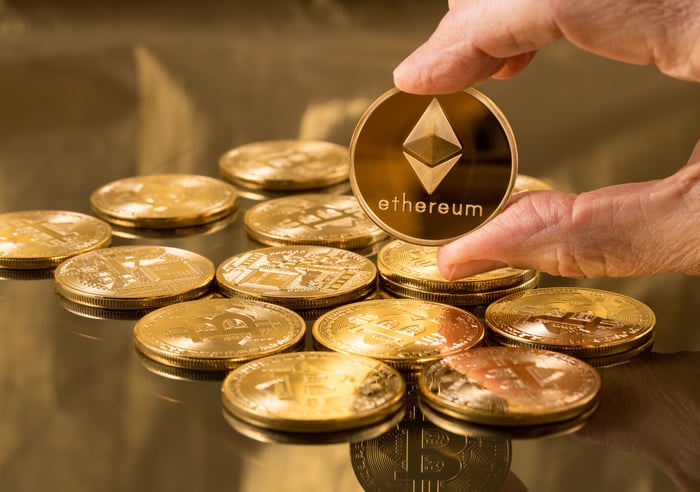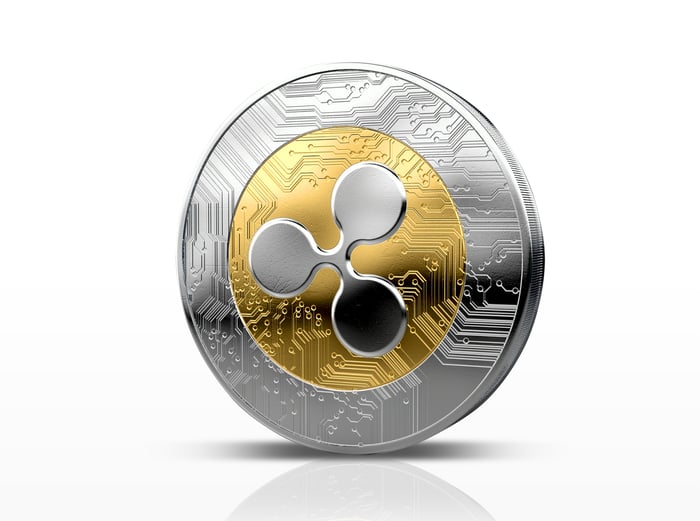What an incredible year it has been for anyone with the right mix of smarts and luck to have invested in cryptocurrencies. At the beginning of the year, according to data from CoinMarketCap.com, the aggregate value of all cryptocurrencies combined was $17.7 billion. But during the evening of Dec. 12, the combined value of more than 1,350 virtual currencies surpassed $500 billion for the first time ever ($503 billion, to be exact). That's a year-to-date increase of more than 2,700%!
Allow that to sink in for a moment -- a half-trillion dollars in value is now being assigned to digital currencies. By comparison, it's taken the broad-based S&P 500 decades to deliver the same returns that some virtual currencies have returned in less than a year's time.

Image source: Getty Images.
The natural inclination here would be to thank bitcoin for this meteoric rise in 2017. After all, bitcoin is the world's most popular cryptocurrency, the most traded digital currency on crypto-exchanges, and the digital coin most accepted by merchants. It also comprises over 56% of the aggregate $503 billion market cap noted above and has risen from less than $1,000 per coin at the beginning of the year to as much as $19,000 per coin recently.
Non-bitcoin cryptocurrencies are soaring
But it's not bitcoin that crypto-investors should be grateful for. Instead, it's the nascent players -- the so-called "next bitcoins" -- that have really contributed to this surge higher, especially during the fourth quarter. At the beginning of the year, the market cap of all cryptocurrencies added together, excluding bitcoin, was just $2.24 billion. As of Dec. 12, the aggregate value of these non-bitcoin cryptos surpassed $210 billion. That's nearly 10,000% growth in less than a year. This is where the real cryptocurrency value is being created at the moment.
What virtual currencies are leading the charge, you ask? Honestly, you could throw a dart and probably be correct, but here are some of the biggest players that have made a monumental difference in 2017.

Image source: Getty Images.
Ethereum
Few cryptocurrencies have made more waves this year than Ethereum, which has now surpassed $700 per Ether token, giving it a market cap of more than $67 billion. Mind you, Ethereum began the year at $7.98, meaning we're talking about an almost 8,700% year-to-date increase in value.
The buzz behind Ethereum revolves around its proprietary blockchain technology, which is being targeted at enterprise clients in a variety of industries. Blockchain is the digital and decentralized ledger that underlies most cryptocurrencies and logs transactions without the need for a third party, like a bank. The Enterprise Ethereum Alliance currently has 200 organizations across the globe testing a version of its blockchain in small-scale and pilot programs.
Furthermore, because its blockchain incorporates smart contracts, or protocols that facilitate, verify, or enforce the negotiation of a contract, Ethereum's blockchain has been in high demand by big businesses.

Image source: Getty Images.
Ripple
Another highflier is Ripple, which has nearly doubled over the past couple of days. The XRP, the virtual currency tethered to Ripple's distributed ledger, has surged more than 7,300% this year, leading to a healthy $18.5 billion market cap.
As is the case with Ethereum, there's a lot of excitement surrounding Ripple's blockchain technology, especially among big banks and financial service companies. In November, American Express (AXP -0.08%) and Banco Santander (SAN 1.93%) announced a partnership with Ripple that'll see these financial juggernauts utilize Ripple's blockchain for cross-border payments. Specifically, American Express customers making non-card payments to U.K. Santander accounts will have those payments routed through Ripple's blockchain. The allure is these transactions should be completed instantly, as opposed to the current system that requires payments be held for days at a time.

Image source: Getty Images.
Litecoin
Adding to the list of top performers is Litecoin, which is also known as "bitcoin Lite." Since the beginning of the year, Litecoin has jumped by over 6,900%, including a tripling in value over just the last 10 trading sessions. Litecoin now sports a market cap of more than $16 billion.
Unlike Ethereum and Ripple, Litecoin's focus is primarily on gaining merchant acceptance. Founder Charles Lee is now devoting his full time and energy into building out Litecoin's merchant network, with online retailer Overstock.com being the most visible merchant snagged thus far.
Litecoin also recently completed the SegWit upgrade to its underlying blockchain. This long-awaited upgrade is designed to improve capacity over Litecoin's blockchain, speed up transaction settlement times, and reduce transaction costs since there's no middleman involved.
Also, like bitcoin, Litecoin has a fixed number of coins that can be mined, adding some degree of scarcity that investors seeking a store of value have appreciated.
It's unclear if these more nascent players have the ability to continue their meteoric rise, but it's pretty evident that these smaller cryptocurrencies have played a critical role in the continuation of this historic run up to this point.





